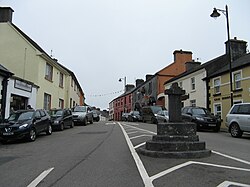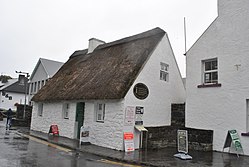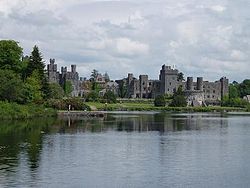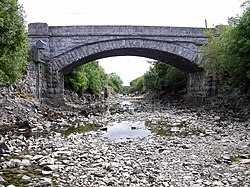Cong
| Cong Irish: Conga or Cunga | |
| County Mayo, County Galway | |
|---|---|
 Main Street | |
| Location | |
| Grid reference: | M150545 |
| Location: | 53°31’60"N, 9°16’60"W |
| Data | |
| Population: | 145 (2016) |
| Post town: | Cong |
| Postcode: | F31 |
| Local Government | |
| Website: | http://www.congvillage.ie |
Cong is a village straddling the borders of County Galway and County Mayo. Its name is from the Irish Cúnga Fheichín meaning "Saint Feichin's narrows".
Geography
Cong is situated on an island formed by a number of streams that surround it on all sides. Cong is located on the isthmus connecting Loughs Corrib and Mask, near the towns of Headford and Ballinrobe and the villages of Clonbur, the Neale and Cross.
Cong is known for its underground streams that connect Lough Corrib with Lough Mask to the north.[1]
History
The 1111 Synod of Ráth Breasail included Cong (Cunga Féichin) among the five dioceses it approved for Connaught, but in 1152 the Synod of Kells excluded it from its list and assigned what would be its territory to the archdiocese of Tuam.[2][3] No longer a residential bishopric, Cunga Féichin is today listed by the Catholic Church as a titular see.[4]
Cong was also the home of Sir William Wilde, historian and father to prominent playwright, novelist, poet, and short-story writer Oscar Wilde. Another poet, Micheál Mac Suibhne, was also born nearby (c 1760).

Cong was the filming location for John Ford's 1952 Oscar-winning film, The Quiet Man,[5] featuring John Wayne, Maureen O'Hara and Barry Fitzgerald. Much of the film was filmed on the grounds of Ashford Castle. The town and castle area remain little changed since 1952, and Cong's connection with the movie make it a tourist attraction. (The film is still celebrated by the local "Quiet Man Fan Club").[6]
Roman Catholic records for Cong did not commence until 1870. Church of Ireland records from the 18th and 19th centuries have survived and are held at the South Mayo Family Research Centre in nearby Ballinrobe.
Attractions

Cong is the home of Ashford Castle, a luxury hotel, which was converted from a Victorian faux lakeside castle, built by the Guinness family. Ashford Castle is a tourist attraction in its own right. Cong also features a ruined mediæval abbey, Cong Abbey, where Rory O'Connor, the last High King of Ireland, spent his last years.[7] It also is the origin of a piece of Celtic art in the form of a metal cross shrine called the Cross of Cong. The 'Cross of Cong' is now held in the National Museum of Ireland, Dublin. There is a High Cross in the village.

The Cong Canal, built over five years by the Commissioners of Public Works between 1848 and 1854 as a combined scheme to provide navigation, drainage and mill-power. In 1854 the Commissioners abandoned the navigation aspect of the scheme and instructed Samuel Roberts, their engineer, "to suspend the execution of all navigation works in this division of the district, and complete only such as were necessary for the regulation of the waters of Lough Mask, for drainage purposes." Now it is commonly known as the "Dry Canal"; the water level can vary between zero and 3.5 meters depending on the time of year (summer dry, winter full) and is 5 km in length. Built heritage features of the canal remain.[8][9][10][11]
Annalistic references
From the Annals of Tigernach, Annals of Connacht, the Annals of the Four Masters:
- "T1135.6 Cúnga Fheichín and Annaghdown and Roscommon were burned."
- "T1138.7 Amlaim Mor mac Firbisigh, ollam O Fiachrach uile re senchus & re filidhecht, & sái clerigh co m-bethaigthib ecailsi imda, & togha do Cunga, & a ec and iar m-buaidh ongtha & aithrige./ Amlaim Mor mac Firbisigh, doctor of all the Uí Fiachrach in history and poetry, a sage of a cleric with many ... of the church, and the choice of Cúnga Fheichín, died there after victory of extreme unction and repentance.
- 1168: "Flannagan Ua Dubhthaigh, bishop and chief doctor of the Irish in literature, history, and poetry, and in every kind of science known to man in his time, died in the bed of Muireadhach Ua Dubhthaigh, at Cúnga."
- "M1184.12. Donnell Ó Flannagáin, Lord of Clann Cahill, died at Cúnga Fheichín."
- Dubthaigh Ó Dubhthaigh, Abbot of Cúnga Fheichín, died 1223
- "1226.5. Aed son of Donn Ó Sochlacháin, erenagh of Cúnga Fheichín, a man eminent for chanting and for the right tuning of harps and for having made an instrument for himself which none had made before, distinguished also in every art such as poetry, engraving and writing and in every skilled occupation, died this year."
- "1226.6. Nuala daughter of Ruaidri O Conchobair, queen of the Ulaid, died at Cúnga Fheichín and was buried with great honour in the Canons' church there."
- "1245.4. Domnall O Flannacain, Abbot of Cúnga, died."
- "Nicol Óg, son of the abbot of Cúnga, put this Life of Féchín out of Latin into Gaelic, and Ó Dubhthaigh took and wrote (it); and this is the year of the age of the Lord today, 1329, etc."
References
- ↑ "Geological Survey of Ireland". https://www.gsi.ie/Programmes/Groundwater/Karst+Booklet/The+western+lowlands.htm. Retrieved 23 March 2015.
- ↑ Michael John Brenan, An Ecclesiastical History of Ireland, Dublin 1864, pp. 120–121, 250
- ↑ John Healy, "Tuam" in Catholic Encyclopedia (New York 1912)
- ↑ Annuario Pontificio 2013 (Libreria Editrice Vaticana 2013 ISBN 978-88-209-9070-1), p. 877
- ↑ Cong on County Mayo Site
- ↑ "The Quiet Man Cong". Member of Travel Ireland Network. 2013. http://www.quietman-cong.com/. Retrieved 24 March 2015.
- ↑ Webb, Alfred (1878). A Compendium of Irish Biography. Dublin: M.H. Gill and Son.
- ↑ "Brief history of Cong Canal". http://www.industrialheritageireland.info/canals/CongCanal/CongCanal.htm. Retrieved 1 August 2005.
- ↑ Hugh McKnight (1987). The Shell Book of Inland Waterways. David & Charles. p. 31. ISBN 0-7153-8239-X.
- ↑ Maurice Semple (1981). By the Corribside. self-published.
- ↑ Board of Public Works (1855). Twenty-third Report from the Board of Public Works, Ireland: with appendices. 1854. HMSO.
Outside links
| ("Wikimedia Commons" has material about Cong) |
